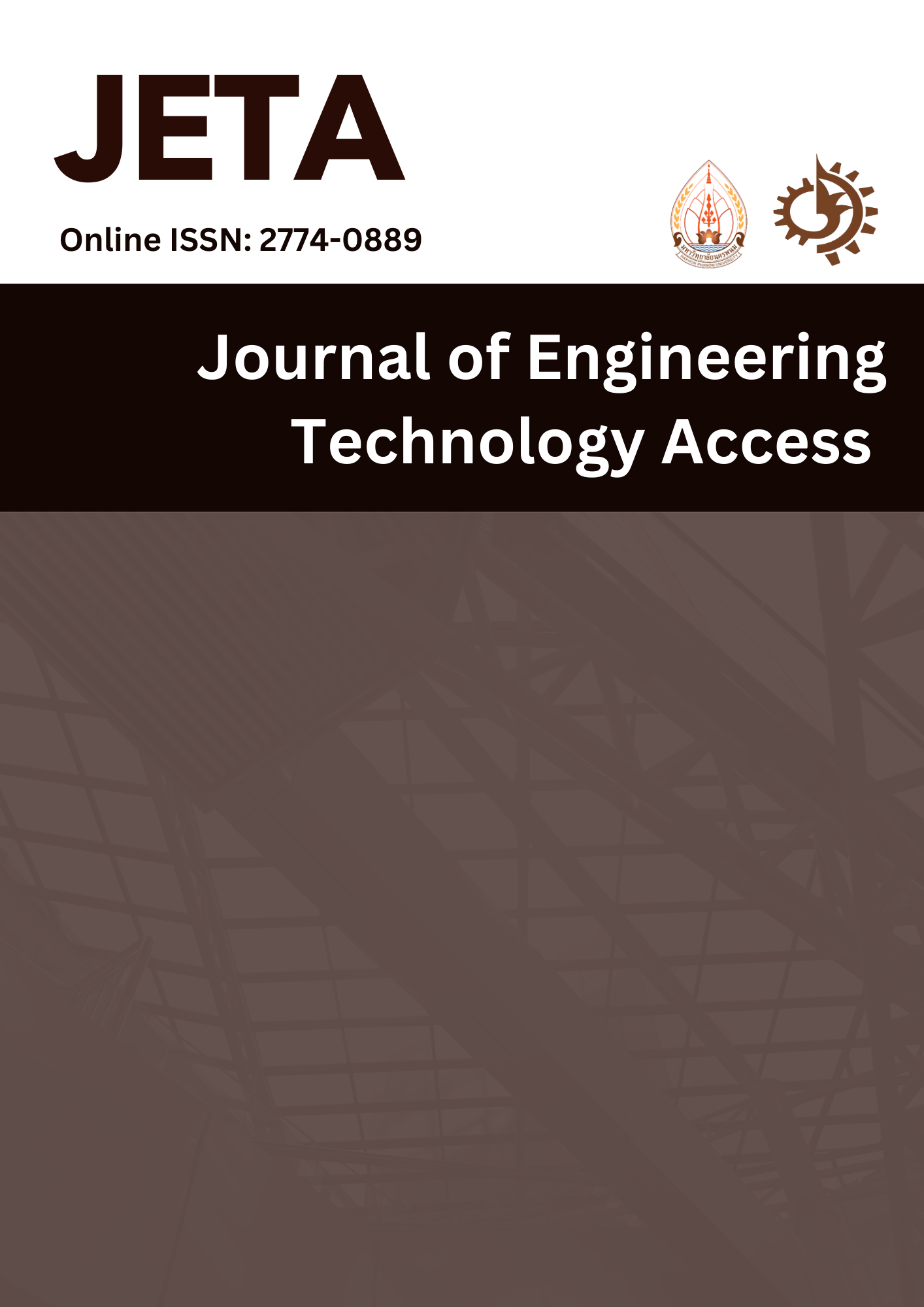คุณสมบัติทางวิศวกรรมของดินซีเมนต์ผสมยางพารา
Main Article Content
บทคัดย่อ
งานวิจัยนี้มีวัตถุประสงค์เพื่อศึกษาคุณสมบัติทางด้านวิศวกรรมอันได้แก่ กำลังรับแรงอัด อิลาสติกโมดูลัส กำลังรับแรงดึงผ่าซีกและค่ากำลังรับแรงดัดของดินลูกรังผสมปูนซีเมนต์ร้อยละ 5 โดยการผสมน้ำยางพาราที่ร้อยละ 0, 5, 10, 15 และ 20 โดยบ่มที่อุณหภูมิห้องเป็นเวลา 7 และ 28 วัน ผลการทดสอบพบว่าค่ากำลังรับแรงอัดที่อายุ 7 วันมีแนวโน้มลดลงอย่างต่อเนื่องเมื่อปริมาณยางพาราเพิ่มขึ้น ค่าอิลาสติกโมดูลัสของดินซีเมนต์ผสมยางพารามีแนวโน้มลดลงเมื่อผสมยางพาราเพิ่มขึ้นสำหรับตัวอย่างทดสอบที่อายุ 7 วันและที่การทดสอบที่อายุ 28 วันแสดงให้เห็นว่าดินซีเมนต์มีความเปราะลดลงเมื่อผสมน้ำยางพารา กำลังรับแรงดึงผ่าซีกของดินซีเมนต์ผสมยางพาราที่ปูนซีเมนต์ 5% ที่อายุ 7 วัน มีแนวโน้มลดลงเมื่อปริมาณยางพารามากขึ้น ในขณะที่การทดสอบอายุ 28 วัน ที่น้ำยางพารา 5% ให้ค่ากำลังรับดึงผ่าซีกสูงสุด และค่ากำลังรับแรงดึงผ่าซีกจะค่อยๆลดลงเมื่อปริมาณน้ำยางพาราเพิ่มมากขึ้น กำลังรับแรงดัดแบบคานของดินซีเมนต์ผสมยางพาราที่อายุ 7 และ 28วัน ที่น้ำยางพารา 5% ให้ค่ากำลังรับแรงดัดสูงสุด แล้วจึงให้ค่ากำลังรับแรงดัดลดลงเมื่อปริมาณน้ำยางที่เพิ่มขึ้น
Article Details

This work is licensed under a Creative Commons Attribution-NonCommercial-NoDerivatives 4.0 International License.
References
Norting & Peckard. (1958). Effect of coarse aggregate remaining on sieve No. 4 on compressive strength of soil cement.
Pheerawat Plangoen. (2018). Application of rubber latex and soil cement develop drought relieving water pond. Eng.J.CMU, 25(2), 170-180.
Jaturonk Saowapakpiboon et al. (2553). Increasing engineering properties of laterite soil by using Portland cement type 1 and Chemroad. The Thailand Research Fund (TRF)
kanchana Pinwiset. (2017). The development of para soil cement road. Engineering Department of Civil Engineering Faculty of Engineering Thammasat University.
Massachusetts Institute of Technology (1954). The use of cement type 3 and type 1 was mixed with cement soil samples. Engineering Massachusetts Institute of Technology.
Mongkol Muchanee. (2010). Compressive strength of repaired road by recycling technique of pavement materials. Master degree of Engineering of Construction and Public Utilities Management in Civil Engineering School of Engineering, Suranaree University of Technology.
Teeracharti Ruenkrairergsa and Sombatkasae Jaratkorn. (2000). Compressive strength of cement soil with different densities. Report No. RD 188 road Research and Development Center Department of highways, Ministry of Transport.
Pheerawat Plangoen and Chuan Chuntavan. (2019). Research and Development of Concrete Ditch Mixed with Rubber Latex for Farm Irrigation System. CRMA Journal, 17(1), 100-116.
Sart Sukprasert et al. (2016). Applications of natural rubber and soil-cement for highway construction. Received a research grant from Suranaree University of Technology, fiscal year 2016.
Suwat Pahusuwanno et al. (2018). A study of para soil cement road construction. The 11th Conference on lrrigation and Drainage of Thailand.
The Office of Industrial Economics & Plastics Institute of Thailand. (2022). Report on the condition of rubber and rubber wood products industry in Thailand. In-depth database system development project for rubber and rubber wood products industry.
Bureau of testing research and development. (1989). Standard No. DH-S 206/2532
Yaowarat, T., Horpibulsuk, S., Arulrajah, A., Mirzababaei, M., and A Rashid, A.S. (2018). Compressive and flexural strength of polyvinyl alcohol–modified pavement concrete using recycled concrete aggregates. J. Mater. Civ. Eng., 30(4): 04018046.
Yaowarat, T, Horpibulsuk, S., Arulrajah, A., Mohammadinia, A., and Chinkulkijniwat, A. (2019). Recycled concrete aggregate modified with polyvinyl alcohol and fly ash for concrete pavement applications. J. Mater. Civ. Eng., 31(7): 04019103.
Karn Kantatham, Suksun Horpibulsuk, Apichat Suddeepong, Apinun Buritatum, Menglim Hoy and Thaworn Takaikaew. (2020). Effect of natural rubber latex on the compressive strength and durability of cement stabilized soil. Suranaree J. Sci. Technol, 28(3):030054 (1-5).





